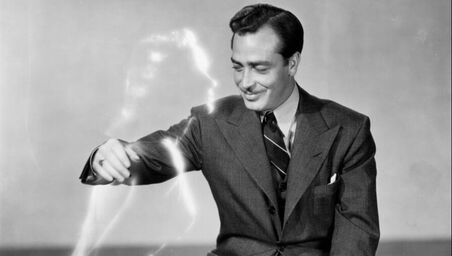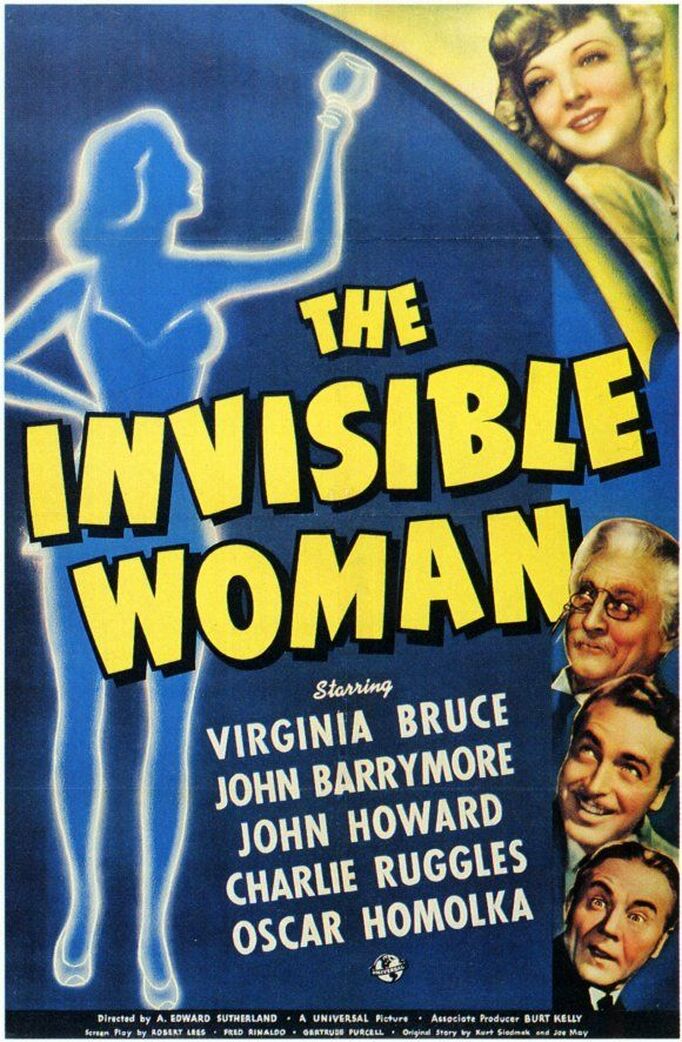 Welcome to our column Creepy Crypts, in which our writers exhume the old, the forgotten, and the long dead horror some of us have forgotten...until now... ...The Invisible Woman (1940) introduces us to Dick Russell (John Howard), a playboy who has exhausted his wealth chasing after women. His one chance for turning his life around is with Professor Gibbs (John Barrymore), a scientist investigating invisibility: if the professor’s experiments are successful, then Dick—as a sometime patron—will get a cut of the profits. Gibbs puts out a call for volunteers and receives exactly one test subject in Kitty Carroll (Virginia Bruce), a model who sees becoming an invisible prankster as the best way to get back at her nasty boss. But things go from the mischievous to the criminal when a band of gangsters decide to steal the invisibility device for themselves… Directed by A. Edward Sutherland from a script that five people had a hand in, The Invisible Woman is very much the odd one out in Universal’s Invisible Man series—despite the story being credited to Joe May and Curt Siodmak, director and co-writer of the previous film The Invisible Man Returns. It doesn’t continue the story of the first two films, with new character Gibbs replacing the Griffin clan, and H. G. Wells receives not so much as a “suggested by” credit. Moreover, the film departs heavily from the series in terms of tone. The Invisible Man Returns had already moved from horror to crime melodrama, but The Invisible Woman takes an abrupt left turn into out-and-out comedy. The comedy isn’t the darkly camp sensibility that James Whale brought to the original Invisible Man, nor is it quite the same as in the Abbott and Costello crossovers that came later, where the monsters were typically played straight even if the protagonists weren’t. This time around, the closest thing to horror is a sequence where Kitty pretends to be a ghost, and even that’s played for laughs. This film is to The Invisible Man what The Nutty Professor is to Dr. Jekyll and Mr. Hyde. Viewers expecting Universal horror may well be thrown for a loop, but as a screwball comedy that happens to have a fantastical central concept, The Invisible Woman is quite charming. The first act offers a wish-fulfilment fantasy that still stands up, with Kitty using her newfound invisibility to play tricks on her domineering, chauvinistic boss and snooty customers. Things get sillier from there, as Kitty’s condition turns out to have the side effect of giving her a weakness for alcohol—meaning that Dick Russell and Professor Gibbs are next in line to be terrorised by the tipsy model-turned-poltergeist. The villainous gangsters are likewise comedy acts who pose no real threat (the fact that one of their number is played by Shemp Howard, sometime member of the Three Stooges, says it all) and wind up as more butts for Kitty’s mischief. It has to be said, The Invisible Woman manages to get maximum mileage out of each concept it has at its disposal. Even one of the film’s weakest gags—a gangster misusing the invisibility machine and ending up with a comically high-pitched voice—is elaborated upon at such length that only the dourest viewer could fail to at least crack a smirk. As comedies go, the film is very broad; but it’s broad comedy that tends to transcend time. More than eighty years down the line, The Invisible Woman remains an enjoyably offbeat entry in the Universal horror cycle. By Doris V. Sutherland Celebrate Women in Horror Month with us by donating to Cinefemme at: Donate (cinefemme.net)
0 Comments
Leave a Reply. |
Archives
March 2023
|


 RSS Feed
RSS Feed